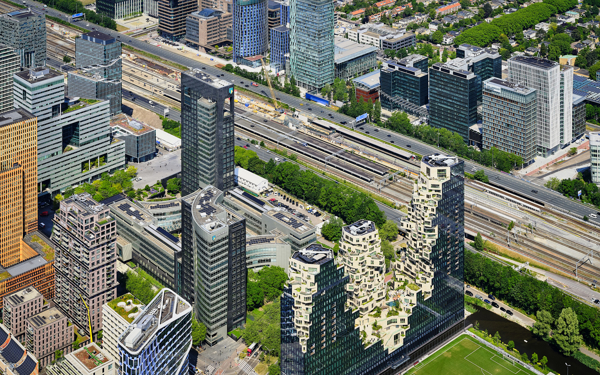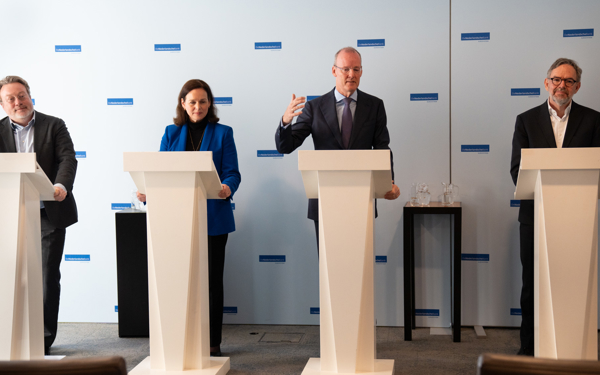Interview Klaas Knot with Nikkei
Klaas Knot spoke with Takerou Minami from Nikkei about monetary policy and financial stability. The interview was published on April 30th 2024.
Read more Interview Klaas Knot with NikkeiYou are using an outdated browser. DNB.nl works best with:

Inflation will fall from 4.1% in 2023 to 2.9% in 2024. Economic growth is low at 0.1% in 2023, but should edge up to 0.3% in 2024. These figures were revealed in our December 2023 Autumn Projections.

© DNB
After a record high of 11.6% in 2022, inflation fell to 4.1% in 2023. We expect a further drop to 2.9% in 2024, hitting closer to the 2% target at 2.2% by 2025. The main causes are lower energy prices and central bank interest rate hikes.
Our economy grew by 0.1% in 2023. This is sharply lower than in 2022, when growth was extra strong thanks to the recovery from the COVID-19 pandemic. In the years ahead, growth will be slightly higher, at 0.3% in 2024 and 1% in 2025.
The main causes of the economy's cooling are the downturn in global trade and the European Central Bank's monetary policy, which is needed to fight high inflation.
The general government budget deficit is still limited to 0.9% of GDP in 2023. However, this situation will deteriorate rapidly in the years ahead, partly because more interest has to be paid on government debt. The deficit will then increase towards the EU threshold of 3%.
Unemployment remains low at 3.6% in 2023, but rises to 4% in 2024. Wages rise sharply, by 5.9% in 2023 and 5.7% in 2024.
DNB issues projections for the Dutch economy over the current and the next two years. We develop them together with the European Central Bank (ECB) and other central banks in the euro area. The ECB aggregates national projections into macroeconomic projections for the euro area as a whole. This is how we contribute to the ECB’s decision-making on monetary policy. And every six months we present our national projections and analyses in the Spring and Autumn Projections. Based on our projections and analyses, we provide advice on economic issues to the government and other policymakers. Our Spring and Autumn Projections and our studies provide insight into the basis of our advice.
The DNB business cycle indicator allows us to identify changes in Dutch economic developments up to six months ahead. We look at consumer confidence in economic conditions, expected business activity in Germany, new manufacturing orders, manufacturing materials procurement and interest rates.
The DNB business cycle indicator (the red line in the figure) turned upwards in March 2024. This means the indicator suggests the economic cycle has bottomed out and that the upward phase of the growth cycle has started.
Read more: Turnaround in the economy

© DNB
We prepare our projections for the Dutch economy with a macroeconomic model named DELFI. We also use it to assess the consequences for the Dutch economy of changes in economic policy or economic conditions. Would you like to try this out, too? Get behind the controls of the Dutch economy with our DELFI-Tool and discover, for example, the consequences of higher energy prices or higher wages.
We regularly publish studies, news releases and speeches on current economic topics. You can find these under ‘Interesting articles’ on this page, under ‘Publications’ or by using the search option.

Klaas Knot spoke with Takerou Minami from Nikkei about monetary policy and financial stability. The interview was published on April 30th 2024.
Read more Interview Klaas Knot with Nikkei
According to the DNB business cycle indicator, the low point of the economic cycle has been reached, after which economic growth will pick up gradually and at a moderate pace this year.
Read more Turnaround in the economy
In the fourth quarter of 2023, foreign multinationals transferred over €300 billion in conduit activities from the Netherlands abroad. These relocations indicate adjustments in business structures, and may be due to the introduction this year of a minimum tax for these international companies.
Read more Conduit activities in the Netherlands declined in fourth quarter of 2023
The Dutch economy is strong and resilient, but not everyone in the Netherlands experiences it that way. Many people are struggling financially or have concerns about their future. The Netherlands should therefore strive for a highly developed and finely tuned economy that works better for everyone.
Read more Towards an economy that works better for everyoneWe use cookies to optimise the user-friendliness of our website.
Read more about the cookies we use and the data they collect in our cookie notice.